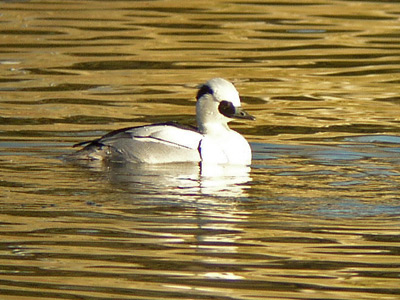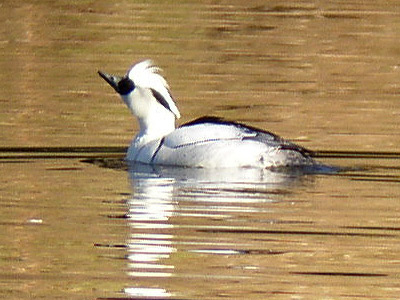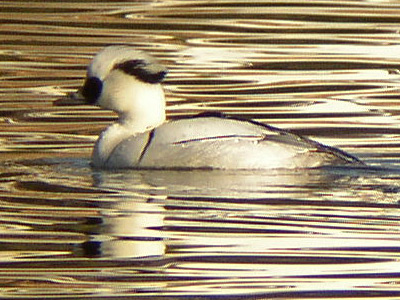Smew (Mergellus albellus)
Soulsbyville, Tuolumne County, California
24 January 2007
Joseph Morlan
Photos © 24 January 2007 by Joseph Morlan. All rights reserved.
 Dan Singer, Robbie Fischer
and I decided to swing by the Willow Springs Pond at the end of King Road in Soulsbyville on our way to Southern
California. Numerous birders were already enjoying fine views of the Smew when we arrived. I studied the bird through
a Nikon FieldScope and took some digiscoped photos by hand-holding my Olympus D550z up to the scope. You can see
the results here. Photography was difficult because the bird was diving almost constantly. It associated loosely
with a group of 2 male and 3 female Hooded Mergansers (Lophodytes cucullatus).
Dan Singer, Robbie Fischer
and I decided to swing by the Willow Springs Pond at the end of King Road in Soulsbyville on our way to Southern
California. Numerous birders were already enjoying fine views of the Smew when we arrived. I studied the bird through
a Nikon FieldScope and took some digiscoped photos by hand-holding my Olympus D550z up to the scope. You can see
the results here. Photography was difficult because the bird was diving almost constantly. It associated loosely
with a group of 2 male and 3 female Hooded Mergansers (Lophodytes cucullatus).
Description
It was a striking small black and white duck. The plumage was mostly white, with bold black patches around and
below each eye and two black lateral stripes on each side of its head, below a loose white crest. These black stripes
formed a point on each side of the nape, but did not appear to connect behind the head (some photos show the black
connecting at the nape). The scapulars were white contrasting with a solid black stripe down the back and outlined
by a thin black line below along the sides. The breast was white with a faint gray line extending forward from
the shoulder and a second better defined black stripe extending straight down to the waterline from the shoulder.
The sides and flanks were white with fine gray vermiculations. The narrow wedge-shaped bill was short, thin and
dark gray with an evident raised round nostril about half way down. The eyes and feet appeared dark. Overall the
bird seemed smaller and more petite than the adjacent Hooded Mergansers.
Discussion
This bird was first seen 20 January 2007 by Steven Umland who was initially unable to identify it because this
species is not included in the Sibley Guide to Birds.
Later he found the species illustrated in the National Geographic Field
Guide to Birds of North America and put out the word. It was confirmed and photographed 21 January 2007.
It left the pond each night but usually returned the next day. It was missed 27 January and has not been seen since
30 January.
There has been some speculation on whether this bird might be an escape from captivity. Observers have noted
that the bird is unbanded, appears to have its rear toes intact, does not come in to grub for handouts with the
domestic ducks, and is relatively rare and expensive in captivity. It is native to northern Eurasia and winters
in northern Africa, eastern China, Korea and Japan. In Alaska, it migrates regularly through the Aleutian Islands
and occurs occasionally in the Pribilofs and on Kodiak Island. Further south in North America, there are at least
three records from British Columbia and there is a record along the Columbia River on the Washington/Oregon border.
Vagrants have also been reported from Ontario, New York and Rhode Island. 
Prior records from California include one seen in January 2000 near Tracy in San Joaquin County discussed here. A brief video of that bird obtained by Maya Decker
is available online here. There is also a record of a male
returning for three consecutive winters at Foster City, San Mateo County starting December 1981. Additional information
on that bird is available here and here.
A briefly described 1995 claim of this species from Buena Vista Lake in Kern County was not accepted by the California
Bird Records Committee. See here for details.
Additional Photos
Many additional photos have been posted on the web. Some of which I am aware are:
- 21 January by Jonathan Katz here.
- 21 January by Gary Woods here.
- 22 January by Martin Meyers here.
- 22 January by Craig Miller here.
- 23 January by Larry Sansone here.
- 24 January by Ryan Terrill here.
- 25 January by Stephen J. Myers here.
- 28 January by Glen Tepke here.
- 28 January video by Leslie Lieurance here.
- 28? January by Monte M. Taylor here. (date uncertain)
- 28 January by Don Roberson here.
- 28 January by Steve Ryan here.
- 29 January by Phil Eager here.
- 29 January by Arlene Ripley here.
Updates
Click here for an article on the Smew
which appeared in the Sonora Union Democrat newspaper.
As always, additions, corrections and comments are welcome!
 Dan Singer, Robbie Fischer
and I decided to swing by the Willow Springs Pond at the end of King Road in Soulsbyville on our way to Southern
California. Numerous birders were already enjoying fine views of the Smew when we arrived. I studied the bird through
a Nikon FieldScope and took some digiscoped photos by hand-holding my Olympus D550z up to the scope. You can see
the results here. Photography was difficult because the bird was diving almost constantly. It associated loosely
with a group of 2 male and 3 female Hooded Mergansers (Lophodytes cucullatus).
Dan Singer, Robbie Fischer
and I decided to swing by the Willow Springs Pond at the end of King Road in Soulsbyville on our way to Southern
California. Numerous birders were already enjoying fine views of the Smew when we arrived. I studied the bird through
a Nikon FieldScope and took some digiscoped photos by hand-holding my Olympus D550z up to the scope. You can see
the results here. Photography was difficult because the bird was diving almost constantly. It associated loosely
with a group of 2 male and 3 female Hooded Mergansers (Lophodytes cucullatus).
